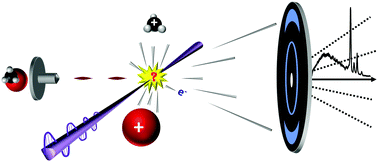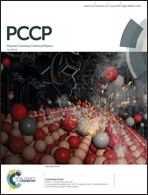Multiphoton Rydberg and valence dynamics of CH3Br probed by mass spectrometry and slice imaging†
Abstract
The multiphoton dynamics of CH3Br were probed by Mass Resolved MultiPhoton Ionization (MR-MPI), Slice Imaging and Photoelectron Imaging in the two-photon excitation region of 66 000 to 80 000 cm−1. Slice images of the CH3+ and Br+ photoproducts of ten two-photon resonant transitions to np and nd Rydberg states of the parent molecule were recorded. CH3+ ions dominate the mass spectra. Kinetic energy release spectra (KERs) were derived from slice and photoelectron images and anisotropy parameters were extracted from the angular distributions of the ions to identify the processes and the dynamics involved. At all wavelengths we observe three-photon excitations, via the two-photon resonant transitions to molecular Rydberg states, forming metastable, superexcited (CH3Br#) states which dissociate to form CH3 Rydberg states (CH3**) along with Br/Br*. A correlation between the parent Rydberg states excited and CH3** formed is evident. For the three highest excitation energies used, the CH3Br# metastable states also generate high kinetic energy fragments of CH3(X) and Br/Br*. In addition for two out of these three wavelengths we also measure one-photon photolysis of CH3Br in the A band forming CH3(X) in various vibrational modes and bromine atoms in the ground (Br) and spin–orbit excited (Br*) states.



 Please wait while we load your content...
Please wait while we load your content...